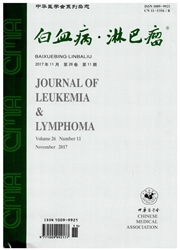

 中文摘要:
中文摘要:
目地 检测弥漫大B细胞淋巴瘤(DLBCL)患者两种预后亚型(生发中心型和非生发中心型)不同治疗阶段的T细胞亚群分布,评估患者的T细胞免疫功能状态。方法 采用流式细胞术(FCM)检测34例DLBCL患者发病初、化疗期间、疗程结束后外周血中的CD+3、CD+4、CD+8和CD+4 CD+25 T细胞的分布情况。以16名健康人外周血作为对照。结果 DLBCL两种预后亚型患者化疗前外周血中CD+4 T细胞比例和CD4/CD8比值分别为(32.27±2.00)%和(0.81±0.39),明显低于正常水平;CD+8 T细胞、CD+4 CD+25 T细胞比例分别为(40.80±6.23)%和(5.68±5.45)%,明显增高。而CD+3 T细胞比例则在整个治疗过程中保持稳定状态,与正常水平比较差异均无统计学意义(均P>0.05)。化疗3个周期后CD+8 T细胞逐渐减少,而CD+4、CD+4 CD+25 T细胞、CD4/CD8比值则明显上升,至化疗6个周期结束后除了CD+4 CD+25 T细胞仍明显高于正常及化疗前水平外,余各项指标与正常水平比较差异均无统计学意义(均P>0.05)。至化疗结束3个月后,CD+4 CD+25 T细胞逐渐下降至接近正常,除了化疗前生发中心型CD+3 和CD+8 T细胞比例[分别为(74.83±3.59)%和(40.80±6.23)%]高于非生发中心型[分别为(68.26±3.56)%和(33.76±5.46)%],不同治疗时期DLBCL患者两种预后亚型间各项指标差异均无统计学意义(t值分别为2.039、2.419,P值分别为0.041、0.018)。不同时期DLBCL患者两种预后亚型间各指标差异均无统计学意义(均P>0.05)。结论 不同基因亚型DLBCL患者不同治疗时期均存在不同程度的细胞免疫受抑,动态监测T细胞亚群的变化可以实时了解患者的T细胞免疫功能状况。
 英文摘要:
英文摘要:
Objective To detect the distribution of T lymphocyte subpopulations at different stages of treatment in diffuse large B-cell lymphoma (DLBCL) patients with distinct gene subtypes (GCB and non-GCB), thereby to evaluate the status of T-cell immunity. Methods Expression of CD+3, CD+4, CD+8, CD+4 CD+25 on T lymphocytes of 34 DLBCL patients was detected by flow cytometry (FCM) before, during, and after chemotherapy. 16 normal individuals served as the controls. Results The proportion of CD+4 T cells and the ratio of CD+4/CD+8 before chemotherapy were (32.27±2.00) % and (0.81±0.39) %, respectively, and were lower than those in the healthy controls. In addition, CD+8 and CD+4 CD+25 T cells were (40.8±6.23) % and (5.68±5.45) %, higher than the controls. Further, CD+3 T cells kept constant through the different stages of treatment, with no statistically significant difference when compared to the normal level. CD+8 T cells were decreased gradually, while CD+4 and CD+4 CD+25 T cells, and the ratio of CD+4/CD+8 were raised dramatically. Except the CD+4 CD+25, all T cell subpopulations came back to the basal level after sixth cycles of chemotherapy. The difference of T cell subpopulations between GCB and non-GCB DLBCL patients was not statistically significant, except the respective proportions of CD+3 and CD+8 T cells (74.83±3.59) % and (40.8±6.23) % in GCB DLBCL patients before chemotherapy were higher than those in the non-GCB DLBCL patients [(68.26±3.56) % and (33.76±5.46) %] (t = 2.039, 2.419, P = 0.041, 0.018). CD+4 CD+25 T cells were decreased gradually and restored to the baseline 3 months after the last cycle of chemotherapy, while they were obviously lower in the GCB DLBCL patients (t = 2.481, P = 0.035). Conclusion There is cellular immunosuppression to some extent at different stages of treatment in DLBCL patients with distinct gene subtypes. It is thus necessary to monitor the changes in T lymphocyte subpo
 同期刊论文项目
同期刊论文项目
 同项目期刊论文
同项目期刊论文
 Treatment with cyclophosphamide, vindesine, cytarabine, dexamethasone, and bleomycin in patients wit
Treatment with cyclophosphamide, vindesine, cytarabine, dexamethasone, and bleomycin in patients wit 期刊信息
期刊信息
